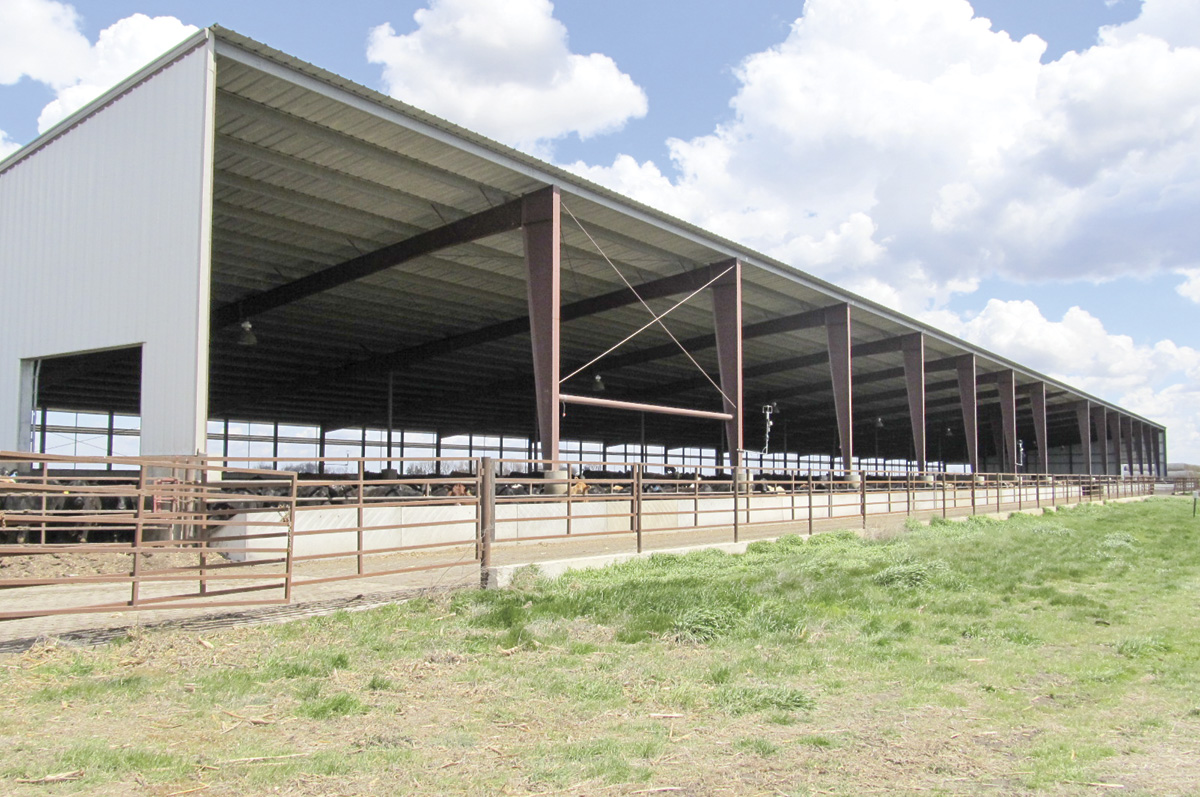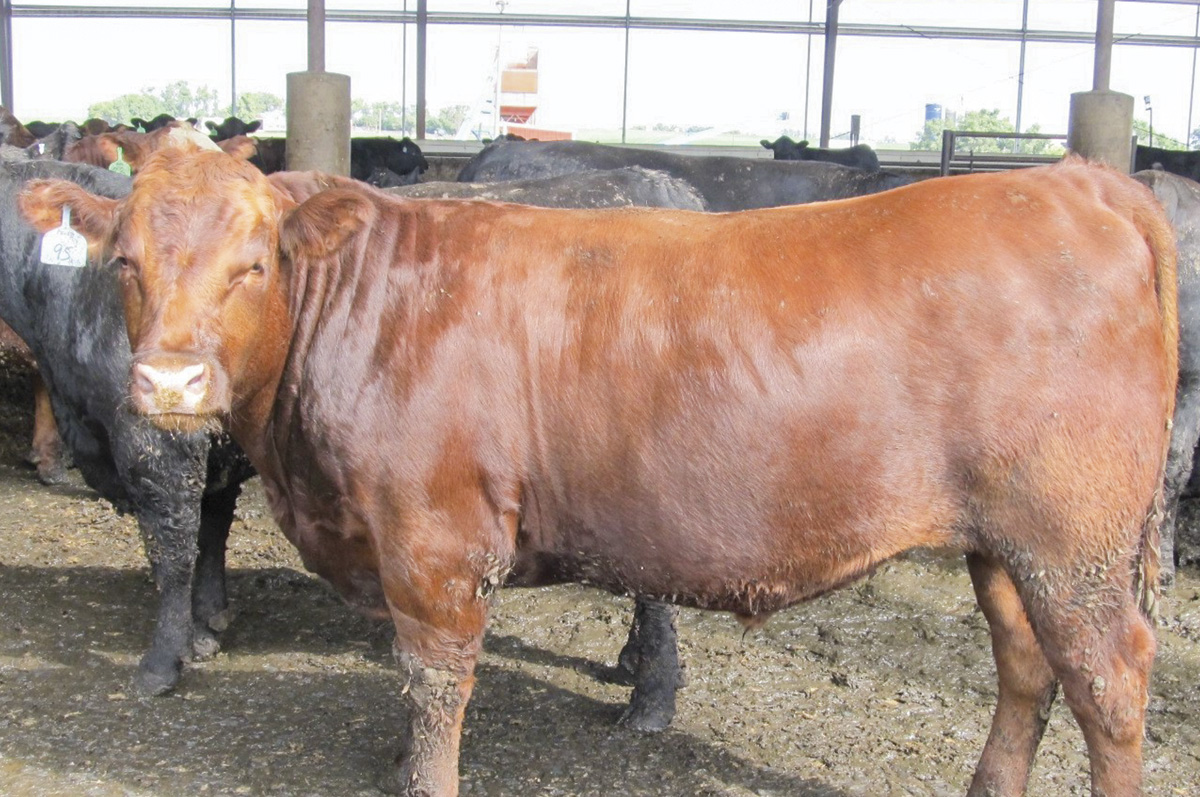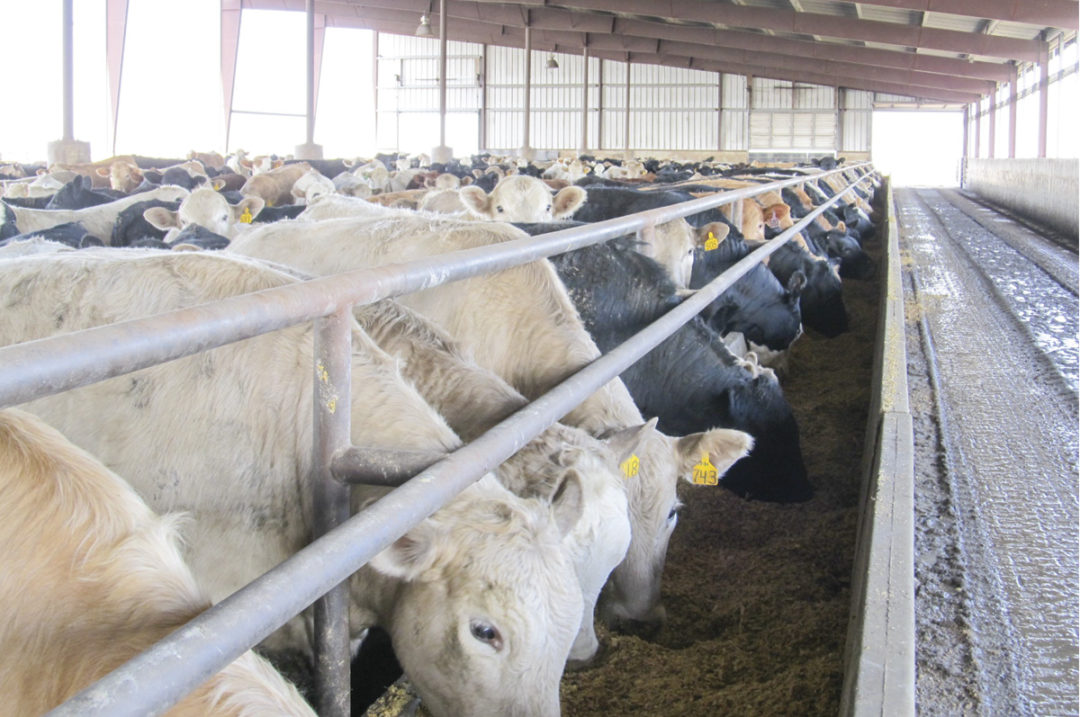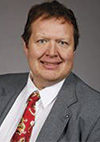Monoslope barns are common in the Upper Midwest and particularly in northwestern Iowa. Initially, they were built to control manure runoff and comply with new environmental regulations. But an informal survey of five feedlot producers revealed two additional advantages: increased animal comfort and performance. However, they pointed out that design and management of the barn are key to success.
Design
Monoslope barns should be sited with an east-west orientation to take advantage of southern winds in the summer and control northern winds in the winter. This orientation also provides maximum shade in the summer and maximum sun in the winter, which enhances animal comfort.
Pen density (measured as square feet per head) varies with pen flooring, animal size or type, and weather. A decade ago, pen densities of 20 to 25 square feet per head for slatted floor barns and 43 to 50 square feet per head for bed-pack barns were suggested. Market weights averaged 1,300 to 1,400 pounds per animal. But market weights have increased over time, with producers now marketing steers at weights ranging from 1,450 to 1,600 pounds. To maintain animal comfort, animals are allotted more space, with pen densities ranging from 50 to 55 square feet per head in deep-bedded facilities. A multistate research study reported that increasing the square footage per animal may be one means to reduce particulate matter (dust).
Monoslope barns are commonly priced on dollars per head space, which is the total cost of the pen area divided by the amount of square feet allotted per head. One way to reduce this number is to reduce the square feet allotted per head (increase the number of head per pen). However, one producer noted, “We struggled with 38 to 40 square feet per head. There were more feet and health issues. Now we allow 50 square feet per head and are marketing steers at 1,480 to 1,500 pounds. This gives us the same pounds of beef per pen with improved animal comfort.”
Adequate bunk space is important in optimizing performance. Old values allotted 12 inches per head for twice-daily feeding of yearling steers. In the current survey, producers cited values ranging from 10 to 16.8 inches per head, with three producers offering more than 13 inches per head.
 This monoslope barn has a wide opening on the southern edge of the barn. Photo provided by Beth Ellen Doran.
This monoslope barn has a wide opening on the southern edge of the barn. Photo provided by Beth Ellen Doran.
Ventilation
Proper management of a monoslope barn cannot be overstated, and the number one factor is ventilation. Most monoslope beef producers regulate ventilation in the barn by adjusting the amount of opening on the north wall curtains. Usually, the curtain is wide open in the summer, whereas in the winter, the opening is usually reduced. One producer remarked, “How you run the curtains is important. In the winter, I have them three-fourths open, and they are never completely closed unless there is a snowstorm or a beating rain.”
Improved air flow through the building provides other benefits. Increased air flow decreases the concentration of gases and particulate matter in the barn compared to low air flow, which potentially can improve animal health. Also, good ventilation decreases the buildup of steam in the barn and helps reduce rust formation on a tin roof. One producer was adamant about avoiding restrictions to air flow, such as placing buildings too close to each other or farming too close to the monoslope.
Some producers are adding fans in their barns to increase ventilation. Increased air movement helps dry out the barn, especially in July and August when the bedding is the wettest and the barn is most humid. One producer commented, “Fans make a difference on hot summer days. They are positioned in the northwest corner of the pens and blow to the south through the front of the building where the opening is the largest.” Another producer added that fans help reduce heat in the bed pack.
All five producers surveyed cleaned around the pack and bedded once or twice a week on average, but noted this varied depending on the weather. As one producer put it, “Bedding and hauling is a necessary evil.”
Corn stover is the choice bedding material, as it is readily available in the region, can absorb a lot of water and quickly evaporates that water. And researchers report no significant increase in odorous compounds over time with corn stover bedding. A bale shredder is commonly used to reduce the particle size of the cornstalks because bedding containing smaller particles absorbs more moisture.
 Regular cleaning and bedding in a monoslope barn enhances cattle cleanliness. Photo provided by Beth Ellen Doran.
Regular cleaning and bedding in a monoslope barn enhances cattle cleanliness. Photo provided by Beth Ellen Doran.
Drawbacks
The major drawback to a deep-bedded monoslope barn is the labor involved weekly in cleaning around the pack and adding bedding. Unlike most other facilities, this is a 52-week commitment.
A second drawback is the amount of bedding required. “Make sure you have stalks on hand if you are going to clean around the pack and bed weekly,” one producer cautioned. “I figure one round cornstalk bale per head per turn.”
Because of the increased labor and quantity of bedding, producers are considering deep-pit, slatted floor barns. But these barns cost more to construct, and cattle lameness is a greater issue if the slats are not covered with mats.
What’s next?
Deep-bedded monoslope barns have a place in cattle feeding. They provide a softer surface, which can reduce foot abrasion in newly placed, lightweight calves and big, heavy market animals. Cattle with darker-colored hides are protected from solar radiation and potential heat stress.
But the future of deep-bedded monoslope barns is poised to become even brighter. With reduced inventory in the beef cow herd, the supply of beef calves is projected to decline, leading feedlot producers to purchase dairy and dairy-cross feeder cattle to fill the void. However, dairy-influenced steers are more susceptible to hot and chilly weather, and lameness can be an issue when the flooring is hard or rough. The monoslope barn could be a solution for housing these animals.








